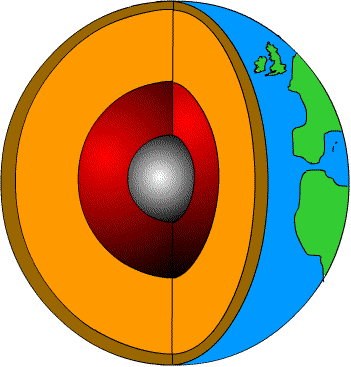
THE
EARTH
|
The Earth is a planet made up of three main shells:
A very thin crust, "the mantle" and the core.
The mantle and core are both divided into two parts. The core and mantle are roughly equal in thickness. However the core is only 15 percent of the Earth's volume, while the mantle is 84 percent. (The crust makes up the last 1 percent).
What we have learned of the structure and composition of the Earth comes from both laboratory and field work. We study the paths and characteristics of earthquake waves. In laboratory we experiment on surface minerals and rocks at high pressure and temperature. We have learned in great detail about the materials of the planet's surface, it's motion in the Solar System, its gravity and magnetic fields, and the flow of heat from inside the Earth.
Because it is accessible the geology of the crust is well studied and and therefor more is known about its structure and composition than of the other shells. Patterns are created when rocks are distributed and deposited in layers by eruption, solidification, erosion, consolidation of rock particles and by crystallization of porous rock. Roughly twelve plates (continents and ocean basins) have moved around on the Earth's surface throughout much of the planet's history. At the plate edges concentrations of earthquakes and volcanoes occur. When plates collide mountains ranges like the Himalayas occur.
Plates include the crust and part of the upper mantle. They move over the upper mantle very slowly, only a few centimeters per year. The crust is thinner under the oceans than under continents.
The boundary between the crust and mantle is called the Mohorovicic discontinuity (sometimes just Moho). This boundary cannot be seen but it is detected by a sharp change in the speed of earthquake waves there.Our knowledge of the upper mantle is indirect. We learn about it from analyses of earthquake waves, heat flow, magnetic and gravity studies. We can also carry out laboratory experiments on the rocks and minerals we believe to be there. Somewhere between 100 and 200 kilometers below the surface the temperature reaches the melting point of rock. When molten rock eruptes from some volcanoes this where it comes from. We believe that it is the upper mantle that carries the tectonic plates. Below this is a transition zone. There are two discontinuities caused by changes in density of minerals. The forms of these minerals are shown by laboratory experiments at high pressure and temperature. The Lower Mantle is believed to be made up of simple iron and magnesium silicate minerals.
The core was the first internal structure to be identified. It helped to explain the Earth's density. The outer core is assumed to be liquid because it does not transmit shear waves and the speed of compressional waves slows sharply. The inner core is thought to be solid because of the way those waves passing through it. Shear waves do not travel through the core but can be converted to compressional waves or they can be reflected. Together with rotations and inertia of the whole Earth, laboratory experiments on iron under pressure and magnetic-field dynamo theory we have built up a picture of the inner and outer core. We believe that the core is composed principally of iron with about 10 percent of some forms of oxygen, sulfur and/or nickel.


